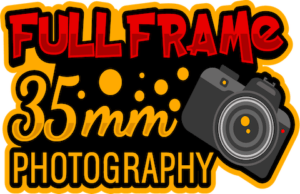Modern DSLRs and mirrorless cameras can be easily categorized in terms of their sensor by the two most common formats available currently, the Full Frame (35mm) and the smaller APS-C.
These two different sensor formats dictate multiple key parameters of the resulting digitals photographs, and I’d like to discuss these important differences in this article.
Size Difference & Crop Factor
In terms of size, the Full Frame sensor follows the traditional dimensions introduced by film photography in the early 20th century by the 35mm film, which is 36 x 24 mm per frame.
At the time of its introduction as a format (back in 1927 by Leica), it was smaller than many existing films. However, it managed to hit a sweet spot between sufficient frame size and portability.
On the other hand, the much more recent APS-C format appeared as a film format in 1996 by Kodak. Its aim was initially the amateur point and shoot cameras.
However, it was later adopted by the booming digital camera industry as a cheaper and easier to manufacture alternative to the larger Full Frame sensors.
This smaller sensor, which is characteristic of the APS-C format, results in a smaller area to capture the desired scene compared to the Full Frame sensor.
The APS-C format has a 1.5/1.6 crop factor, resulting in an image of a much tighter composition that has a feeling of being zoomed in when compared with the same scene in a Full Frame camera.
This crop factor is the most significant limitation of the APS-C sensor.
The reason is that it is considerably more difficult to successfully compose the desired scene and include all the elements that you believe to be crucial in a composition.
Of course, this disadvantage is even more profound in landscape photography and architecture photography, or any other situation that demands the photographer to be flexible and capture a larger area.
On the other hand, the smaller size of the APS-C sensor might be useful in a street photography scenario.
The smaller APS-C cameras have an advantage for long days out shooting.
However, they will rarely outperform a decent Full Frame camera in regards to image quality.
It is important to note that the composition of macro photography isn’t negatively affected by the crop factor. The reason is that it rarely is a need to capture a larger area through your lens.
Telephotography is aided by the 1.5/1.6 crop factor, as a lens which is 200mm on a full-frame camera will behave more or less like a 300mm one in a camera that has an APS-C sensor.
This telephoto advantage doesn’t mean that the resulting image will be better (as image quality is a whole different story to be discussed later).
The photographer might initially think that the image is zoomed in, but if you crop a full-frame image, the result will be more or less the same.
Finally, a Full Frame sensor will usually greatly outperform an APS-C sensor in a session that utilizes wide-angle lenses.
This case is where the extra coverage of the Full Frame is exploited and results in expanding compositions that are impossible to capture with an APS-C sensor without an extremely wide-angle lens.
Lastly, it is essential to discuss the Depth of Field (DOF). DOF is another crucial factor where Full Frame cameras are much more appealing compared to APS-C cameras.
APS-C camera’s crop factor force you to stand further away from your subject in many situations (using the same focal length). Due to this, it is much harder to utilize a very shallow depth of field.
Therefore, creating a more dynamic composition, with a background that has beautiful and creamy bokeh is more problematic.
On the other hand, you can get closer with a Full Frame camera and take some shots that would be more difficult to take with the cropped sensor.
You can utilize many more exciting choices in terms of background bokeh and other such artistic features. These features enhance your picture composition using the larger sensor.
Image Quality
The image quality offered by a Full Frame sensor easily surpasses an APS-C one, for many reasons.
First of all, due to their larger size, Full-frame sensors have larger pixels and a lower pixel density. This pixel density is responsible for two main advantages: More light captured and less noise generated.
The larger pixels of the Full Frame sensor capture more light from the scene, even at comparatively lower ISO settings.
Many APS-C sensors struggle and have to increase their ISO sensitivity quite considerably to compensate for their smaller sensor and pixels.
Higher ISO leads to a second disadvantage. Higher ISO means that you introduce more noise, especially smaller sensor cameras which can’t easily handle higher ISO sensitivity.
It is also worth noting that if the scene is so dim that even a Full Frame sensor needs to utilize a higher level of sensitivity. Due to their lower pixel density, there is much less noise generated.
This advantage allows you to elevate the ISO count without having the noise issues of an APS-C sensor.
These two significant advantages give a clear edge to the Full Frame sensor in situations with lower light levels, with more contrast and more dynamic changes to the ambient light.
It is also exceedingly important in capturing scenes that demand rapid shutter speeds (like sports) and thus higher ISO sensitivity to compensate for the shorter exposure.
Conclusion
Excluding the fact that APS-C cameras and lenses are lighter and cheaper, it is tough to find a task where they can outperform their larger Full Frame counterparts.
Summarizing, we can see that full-frame cameras offer the following main advantages:
- Larger compositions
- Shallower and more dynamic depth of field
- Greater versatility
- Better image quality
- Better performance at low light and high ISO situations
If you wish to invest time and money in photography and desire great results, full-frame cameras seem like the best choice for the aspiring professional photographer.



